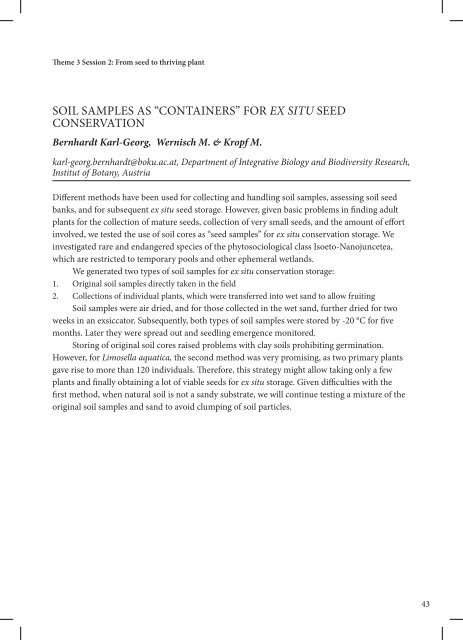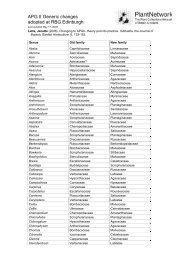Botanic gardens in the age of climate change - PlantNetwork
Botanic gardens in the age of climate change - PlantNetwork
Botanic gardens in the age of climate change - PlantNetwork
Create successful ePaper yourself
Turn your PDF publications into a flip-book with our unique Google optimized e-Paper software.
Theme 3 Session 2: From seed to thriv<strong>in</strong>g plant<br />
SOIL SAMPLES AS “CONTAINERS” FOR EX SITU SEED<br />
CONSERVATION<br />
Bernhardt Karl-Georg, Wernisch M. & Kropf M.<br />
karl-georg.bernhardt@boku.ac.at, Department <strong>of</strong> Integrative Biology and Biodiversity Research,<br />
Institut <strong>of</strong> Botany, Austria<br />
Different methods have been used for collect<strong>in</strong>g and handl<strong>in</strong>g soil samples, assess<strong>in</strong>g soil seed<br />
banks, and for subsequent ex situ seed stor<strong>age</strong>. However, given basic problems <strong>in</strong> f<strong>in</strong>d<strong>in</strong>g adult<br />
plants for <strong>the</strong> collection <strong>of</strong> mature seeds, collection <strong>of</strong> very small seeds, and <strong>the</strong> amount <strong>of</strong> effort<br />
<strong>in</strong>volved, we tested <strong>the</strong> use <strong>of</strong> soil cores as “seed samples” for ex situ conservation stor<strong>age</strong>. We<br />
<strong>in</strong>vestigated rare and endangered species <strong>of</strong> <strong>the</strong> phytosociological class Isoeto-Nanojuncetea,<br />
which are restricted to temporary pools and o<strong>the</strong>r ephemeral wetlands.<br />
We generated two types <strong>of</strong> soil samples for ex situ conservation stor<strong>age</strong>:<br />
1. Orig<strong>in</strong>al soil samples directly taken <strong>in</strong> <strong>the</strong> field<br />
2. Collections <strong>of</strong> <strong>in</strong>dividual plants, which were transferred <strong>in</strong>to wet sand to allow fruit<strong>in</strong>g<br />
Soil samples were air dried, and for those collected <strong>in</strong> <strong>the</strong> wet sand, fur<strong>the</strong>r dried for two<br />
weeks <strong>in</strong> an exsiccator. Subsequently, both types <strong>of</strong> soil samples were stored by -20 °C for five<br />
months. Later <strong>the</strong>y were spread out and seedl<strong>in</strong>g emergence monitored.<br />
Stor<strong>in</strong>g <strong>of</strong> orig<strong>in</strong>al soil cores raised problems with clay soils prohibit<strong>in</strong>g germ<strong>in</strong>ation.<br />
However, for Limosella aquatica, <strong>the</strong> second method was very promis<strong>in</strong>g, as two primary plants<br />
gave rise to more than 120 <strong>in</strong>dividuals. Therefore, this strategy might allow tak<strong>in</strong>g only a few<br />
plants and f<strong>in</strong>ally obta<strong>in</strong><strong>in</strong>g a lot <strong>of</strong> viable seeds for ex situ stor<strong>age</strong>. Given difficulties with <strong>the</strong><br />
first method, when natural soil is not a sandy substrate, we will cont<strong>in</strong>ue test<strong>in</strong>g a mixture <strong>of</strong> <strong>the</strong><br />
orig<strong>in</strong>al soil samples and sand to avoid clump<strong>in</strong>g <strong>of</strong> soil particles.<br />
43





